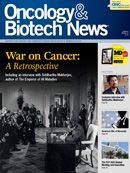Publication
Article
ASH 2010: Multiple Benefits Observed for Bortezomib in Newly Diagnosed Myeloma Patients
Author(s):
In patients with newly diagnosed multiple myeloma who are candidates for transplant, bortezomib (Velcade) achieved high complete response (CR) rates during induction, delayed disease progression, and improved overall survival (OS).
In patients with newly diagnosed multiple myeloma who are candidates for transplant, bortezomib (Velcade) achieved high complete response (CR) rates during induction, delayed disease progression, and improved overall survival (OS). The final analysis of the HOVON-65/GMMGHD4 phase II trial (conducted in Germany, the Netherlands, and Belgium) also found that bortezomib maintenance therapy produced higher rates of CR and near CR at all treatment stages and improved outcomes for patients having a poor prognosis due to genetic abnormalities. Data were presented by Pieter Sonneveld, MD, PhD, Erasmus Medical Center, Rotterdam, the Netherlands.
HOVON-65/GMMG-HD4 Protocol
The HOVON-65/GMMG-HD4 study enrolled 744 patients with newly diagnosed, symptomatic multiple myeloma who were candidates for highdose therapy. Patients were randomized to 3 cycles of vincristine, doxorubicin, and dexamethasone (VAD; Arm A) or bortezomib, doxorubicin, and dexamethasone (PAD; Arm B). Allogeneic stem cell transplant (ASCT) was offered to patients in both study arms who had a human leukocyte antigen— identical donor. The intent of the trial was to evaluate the efficacy of bortezomib used as part of an induction regimen and a maintenance regimen.
Patients in the PAD arm received 1.3 mg/m2 of bortezomib on days 1, 4, 8, and 11; 9 mg/m2 of doxorubicin on days 1-4, and 40 mg of dexamethasone on days 1-4, 9-12, and 17-20. Transplant-eligible patients received 1 or 2 administrations of high-dose melphalan (HDM) with ASCT. The maintenance protocol consisted of 50 mg of thalidomide daily for 2 years for patients assigned to Arm A and 1.3 mg/m2 of bortezomib twice weekly for patients in Arm B. The protocolspecified analysis was intent-to-treat and was censored for the 58 patients who received ASCT after a single course of HDM1.
At a median follow-up of 40 months, 90% of patients had completed induction and 84% had completed HDM. Of the 239 patients in the VAD arm who began thalidomide maintenance therapy, 55% were still taking it at 12 months’ follow-up and 29% were receiving it at 24 months’ followup. A total of 205 patients in the PAD arm initiated bortezomib-based maintenance therapy; 76% were taking it at 12 months’ follow-up and 49% were receiving it at 24 months’ follow-up. “At any stage of treatment, more patients remained on the bortezomib-based regimen,” Sonneveld noted, adding that responses at each stage were higher with PAD (Table). Both maintenance regimens led to additional response in the majority of patients.
Bortezomib Improves Survival
Patients treated with the PAD regimen were significantly less likely than patients taking VAD to experience disease progression. In patients on a bortezomib-based regimen, progressionfree survival (PFS) increased from a median of 27 months with standard treatment to 36 months, said Sonneveld. At 36 months, the risk of progression overall was 21% lower for patients on the PAD regimen than for those on the VAD regimen (P = .01); excluding transplant patients, the risk of progression for patients in the PAD group at 36 months was 25% lower (P = .001) than it was for patients in the VAD group. Sonneveld reported that bortezomib was also associated with significant improvement in OS, with a 27% lower risk of mortality for patients in the PAD cohort than for those in the VAD group (P = .02).
“Subgroup analyses by cytogenetic abnormalities clearly showed the standard arm to be less effective,” he said (Figure). “Bortezomib treatment overcame the poor risk caused by these abnormalities.”
In the VAD cohort, only 29% of patients with the -13/13q- mutation had PFS ≥36 months, and the rate of 36-month OS for this subgroup was 58%; for those patients with the t(4:14) translocation, only 20% had PFS ≥36 months, with a 36-month OS rate of 40%; in patients with a 17p deletion, 16% experienced PFS ≥36 months and these patients had a 36-month OS rate of 17%.
Assignment to PAD conveyed much better outcomes for patients with these genetic mutations, with 40% of patients with the -13/13qmutation experiencing PFS ≥36 months and having a 36-month OS rate of 79%. Looking at the subgroup of patients receiving PAD who had the t(4:14) translocation, 28% had PFS ≥36 months, with a 36-month OS rate of 60%; 22% of patients with a 17p deletion experienced PFS ≥36 months and the 36-month OS rate for patients with this abnormality was 61%.
During the 2 years of maintenance therapy, peripheral neuropathy was observed in 41% of patients in the VAD arm, with 15% experiencing grades 3/4 neuropathy. In the PAD arm, the rate of peripheral neuropathy reached 23%, with 9% experiencing a grade 3/4 level of this adverse effect. More patients in the VAD arm than in the PAD arm discontinued treatment because of toxicity (31% vs 9%, respectively).
___________________________________________________________________________
Sonneveld P, Schmidt-Wolf I, van deer Holt B, et al. HOVON-65/GMMG-HD4 randomized phase III trial comparing bortezomib, doxorubicin, dexamethasone (PAD) vs VAD followed by high-dose melphalan (HDM) and maintenance with bortezomib or thalidomide in patients with newly diagnosed multiple myeloma. Presented at: 52nd ASH Annual Meeting and Exposition; December 4-7, 2010; Orlando, Florida.










